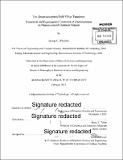| dc.contributor.advisor | Harry L. Tuller. | en_US |
| dc.contributor.author | Whitfield, George C. (George Calvin) | en_US |
| dc.contributor.other | Massachusetts Institute of Technology. Department of Materials Science and Engineering. | en_US |
| dc.date.accessioned | 2016-03-25T13:41:09Z | |
| dc.date.available | 2016-03-25T13:41:09Z | |
| dc.date.issued | 2012 | en_US |
| dc.identifier.uri | http://hdl.handle.net/1721.1/101861 | |
| dc.description | Thesis: Ph. D., Massachusetts Institute of Technology, Department of Materials Science and Engineering, 2012. | en_US |
| dc.description | "February 2012." Cataloged from student-submitted PDF version of thesis. | en_US |
| dc.description | Includes bibliographical references (pages 295-300). | en_US |
| dc.description.abstract | Chemisorption on semiconducting metal oxides is in general of great importance to the fields of clean energy, heterogeneous catalysis, nanoelectronics, and trace chemical detection. The purpose of this thesis is to illuminate this process by means of an investigation that utilizes the electric field effect to control surface chemistry and is both theoretical and experimental in nature. In addition, a fundamental semiconducting device is formally described by numerical derivation of its heterogeneous electrochemical properties at nanoscale. This work concerns a chemical sensor that bears close similarity to a buried-gate thin film transistor (TFT) but differs conceptually in that it can control and measure charge density associated with chemisorption that occurs at an outer surface of the semiconducting channel. Similar device structures have been investigated experimentally within the chemical sensor community, without a thorough treatment of the complex interaction between surface forces and materials properties at the nanoscale. As a result, today there is not a widely accepted model for chemisorption based chemical sensors. This thesis employs a finite element analysis of chemisorption effects in nanostructured semiconductors, in an integrated analytical, numerical, and experimental approach, and applies it towards understanding the behavior of this device, which can be called an Electroadsorption Field Effect Transistor (EA-FET). The EA-FET is a four terminal device (3 electrical, 1 chemical), possessing electronic and electrochemical properties that are derived numerically in this thesis work. In the case of the chemical terminal, charge is transferred by means of chemisorption and desorption processes. The device has been tested and compared to numerical simulations. As result of the analysis, key fundamental properties of the device are derived, regimes of operation are characterized, and a lumped element model is developed, in an effort to make the influence of chemisorption accessible in a practical electrical engineering context. In addition to studies of the EA-FET, related influences on chemical sensor performance are investigated, including the roles of illumination and thin film morphology. | en_US |
| dc.description.statementofresponsibility | by George C. Whitfield. | en_US |
| dc.format.extent | 300 pages | en_US |
| dc.language.iso | eng | en_US |
| dc.publisher | Massachusetts Institute of Technology | en_US |
| dc.rights | M.I.T. theses are protected by copyright. They may be viewed from this source for any purpose, but reproduction or distribution in any format is prohibited without written permission. See provided URL for inquiries about permission. | en_US |
| dc.rights.uri | http://dspace.mit.edu/handle/1721.1/7582 | en_US |
| dc.subject | Materials Science and Engineering. | en_US |
| dc.title | The Electroadsorption Field Effect Transistor : numerical and experimental treatment of chemisorption on nanostructured chemical sensors | en_US |
| dc.title.alternative | Numerical and experimental treatment of chemisorption on nanostructured chemical sensors | en_US |
| dc.title.alternative | EA-EFT : numerical and experimental treatment of chemisorption on nanostructured chemical sensors | en_US |
| dc.type | Thesis | en_US |
| dc.description.degree | Ph. D. | en_US |
| dc.contributor.department | Massachusetts Institute of Technology. Department of Materials Science and Engineering | |
| dc.identifier.oclc | 944026389 | en_US |
